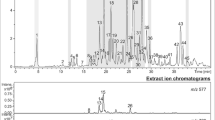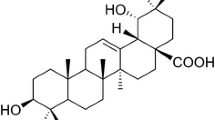Abstract
In the present study, the antinociceptive profiles of Aralia cordata Thunb. extract were examined in ICR mice. A. cordata extract administered orally (200 mg/kg) showed an antinociceptive effect as measured by the tail-flick and hot-plate tests. A. cordata extract attenuated the writhing numbers in the acetic acid-induced writhing test and reduced the cumulative nociceptive response time for intrathecal (i.t.) injection of substance P (0.7 ώg). Intraperitoneal (i.p.) pretreatment with yohimbine (α2-adrenergic receptor antagonist) attenuated antinociceptive effect induced by A. cordata extract in the writhing test, whereas naloxone (opioid receptor antagonist) and methysergide (5HT2 serotonergic receptor antagonist) did not affect antinociception. Results suggest that A. cordata extract has an antinociceptive property in various pain models and may be mediated by α2-adrenergic receptor, but not by opioidergic and 5HT2 serotonergic receptors.
Similar content being viewed by others
References
Chapman CR, Casey KL, Dubner R, Foley KM, Gracely RH, and Reading AE (1985) Pain measurement: An overview. Pain 22, 1–31.
Choi SS, Han KJ, Lee JK, Lee HK, Han EJ, Kim DH, and Suh HW (2003) Antinociceptive mechanisms of orally administered decursinol in the mouse. Life Sci 13(73), 471–485.
Cumberbatch MJ, Herrero JH, and Headley PM (1994) Exposure of rat spinal neurons to NMDA, AMPA and kainate produces only short-term enhancements of responses to noxious and non-noxious stimuli. Neurosci Lett 181, 98–102.
Dang NH, Zhang X, Zheng M, Son KH, Chang HW, Kim HP, Bae K, and Kang SS (2005) Inhibitory constituents against cyclooxygenases from Aralia cordata Thunb. Arch Pharm Res 28, 28–33.
D’Amour FE and Smith DL (1941) A method for determining loss of pain sensation. J Pharmacol Exp Ther 72, 74–9.
Eddy NB and Leimbach D (1953) Synthetic analgesics. II. Dithienylbutenyl- and dithienylbutylamines. J Pharmacol Exp Ther 107, 385–93.
Grumbach L (1966) The prediction of analgesic activity in man by animal testing. In Pain, Knighton RS and Dumke PR (eds), pp. 163–82. Boston: Little Brown and Co, Boston, USA
Han BH, Han YN, Han LA, Park MH, and Lee EO (1983) Studies on the anti-inflammatory activity of Aralia contineltalis. Arch Pharm Res 6, 17–23.
Hylden JL and Wilcox GL (1980) Intrathecal morphine in mice: a new technique. Eur J Pharmacol 67, 313–316.
Hylden JL and Wilcox GL (1981) Intrathecal substance P elicits a caudally- directed biting and scratching behavior in mice. Brain Res 217, 212–215.
Jensen TS and Yaksh TL (1984) Spinal monoamine and opiate systems partly mediate the antinociceptive effects produced by glutamate at brainstem sites. Brain Res 321, 287–297.
Kim JS and Kang SS (1998) Saponins from the aerial parts of Aralia continentalis. Nat Prod Sci 4, 45–50.
Kim TD, Lee JY, Cho BJ, Park TW, and Kim CJ (2010) The analgesic and anti-inflammatory effects of 7-oxosandaracopimaric acid isolated from the roots of Aralia cordata. Arch Pharm Res 33(4), 509–14.
Koster R, Anderson M, and Beer EJ (1959) Acetic acid for analgesic screening. Federal Proceeding 18, 412.
Lee IS, Jin W, Zhan X, Hung TM, Song KS, Seong YH, and Bae K (2006) Cytotoxic and COX-2 inhibitory constituents from the aerial parts of Aralia cordata. Arch Pharm Res 29, 548–555.
Okuyama E, Nishimura S, and Yamazaki M (1991) Analgesic principles from Aralia cordata Thunb. Chem Pharm Bull 39, 405–407.
Park HJ, Hong MS, Lee JS, Leem KH, Kim CJ, Kim JW, and Lim S (2005) Effects of Aralia continentalis on hyperalgesia with peripheral inflammation. Phytother Res 19, 511–513.
Park SH, Sim YB, Choi SM, Seo YJ, Kwon MS, Lee JK, and Suh HW (2009) Antinociceptive Profiles and Mechanisms of Orally Administered Vanillin in the Mice. Arch Pharm Res 32(11), 1643–1649.
Schmauss C and Yaksh TL (1984) In vivo studies on spinal opiate receptor systems mediating antinociception. II. Pharmacological profiles suggesting a differential association of mu, delta and kappa receptors with visceral chemical and cutaneous thermal stimuli in the rat. J Pharmacol Exp Ther 228, 1–12.
Suh HW, Chung KM, Kim YH, Huh SO, and Song DK (1999) Effect of histamine receptor antagonists injected intrathecally on antinociception induced by opioids administered intracerebroventricularly in the mouse. Neuropeptides 33, 121–129.
Suh HW, Song DK, and Kim YH (1997) Differntial effects of adenosine receptor antagonist injected intrathecally on antinociception induced by morphine and beta-endorphin administered intracerebroventricularly in the mouse. Neuropeptides 31, 339–344.
Suh HW, Song DK, Son KH, Wie MB, Lee KH, Jung KY, Do JC, and Kim YH (1996) Antinociceptive mechanisms of dipsacus saponin C administered intracerebroventricularly in the mouse. Gen Pharmacol 27, 1167–1172.
Vyklicky L (1979) The techniques for the study of pain in animals. In Advances in Pain Research and Theraphy, 3, pp. 727–745, Raven, New York, USA.
Wigdor S and Wilcox GL (1987) Central and systemic morphine-induced antinociception in mice: contribution of descending serotonergic and noradrenergic pathways. J Pharmacol Exp Ther 242, 90–95.
Yaksh TL (1979) Direct evidence that spinal serotonin and noradrenaline terminals mediate the spinal antinpciceptive effects of morphine in the periaqueductal gray. Brain Res 160, 180–185.
Yaksh TL (1984) Multiple opioid receptor systems in brain and spinal cord: Part I. Eur J Anaesth 1, 171–199.
Author information
Authors and Affiliations
Corresponding author
Additional information
These authors contributed equally to this work.
Rights and permissions
About this article
Cite this article
Park, SH., Sim, YB., Lim, SS. et al. Antinociception profiles and mechanisms of orally administered Aralia cordata Thunb. Extract in the mouse. J. Korean Soc. Appl. Biol. Chem. 54, 54–58 (2011). https://doi.org/10.3839/jksabc.2011.007
Received:
Accepted:
Issue Date:
DOI: https://doi.org/10.3839/jksabc.2011.007




